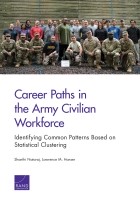| 来源类型 | Research Reports
|
| 规范类型 | 报告
|
| DOI | https://doi.org/10.7249/RR2280
|
| ISBN | 9780833099891
|
| 来源ID | RR-2280-A
|
| Career Paths in the Army Civilian Workforce: Identifying Common Patterns Based on Statistical Clustering |
| Shanthi Nataraj; Lawrence M. Hanser
|
| 发表日期 | 2018
|
| 出版年 | 2018
|
| 页码 | 112
|
| 语种 | 英语
|
| 结论 |
Army civilians exhibit a diverse array of career trajectories, and most entrants into the Army civilian workforce spend a relatively short amount of time there- The researchers identified seven common career patterns among Army civilians.
- Nearly two-thirds of all individuals in the cluster analysis were identified with a career pattern characterized as "Short-Term"; individuals in this career pattern spend an average of 5 years in the Department of Defense (DoD) civilian workforce.
Career patterns are related to a variety of individual and job characteristics- Women are more likely to be in career patterns that include short-term service, service in low grades, and a long gap in service.
- Black and Hispanic individuals are more likely to be in one of the low-grade career patterns and less likely to be in the higher-grade patterns, relative to white individuals.
- The youngest and oldest entrants into the DoD civilian workforce are more likely to be in the short-term pattern. However, young entrants are also more likely to be in career patterns characterized by eventual promotion to the highest grades, in the Army as well as in other parts of DoD.
- More-educated individuals are more likely to be found in higher-grade patterns, which is consistent with higher educational requirements for positions at higher pay grades.
- Individuals with prior military service are much less likely to be in the short-term pattern. They are also more likely to be mobile across DoD components and to exhibit a gap in service.
|
| 摘要 |
- Collect systematic information about why employees leave the Army civilian workforce. This can help workforce managers consider whether the high rate of departure during the first few years is a concern.
- Collect information on motivations for moving to the Army from another federal agency. The Army may provide better career advancement opportunities in certain occupations or locations; if this is the case, Army workforce managers may wish to build on these advantages in recruiting talent from elsewhere in the federal government, or to replicate similar conditions in other areas.
- Consider whether hiring outreach strategies could be modified to increase diversity in higher pay grades. A focused effort to encourage the hiring of women in occupations that are associated with longer-term service in higher grades may improve diversity in the pipeline for leadership positions. Similar targeting with respect to prior military service or education credentials may also be effective.
- Examine whether observed career patterns are similar across different segments of the civilian workforce. This can aid career program managers in offering more-effective career guidance to employees and building a workforce with the desired experience mix.
- Explore whether resources are being effectively applied within the civilian workforce. A first step toward this goal would be to systematically document how training resources are distributed across geographic locations, commands, and career programs, as well as individual career stages. Further analysis could then examine whether the application of those training resources is associated with desired retention and promotion outcomes.
|
| 主题 | Civilian Military Workforce
; Military Career Field Management
; Military Education and Training
; Occupational Training
; United States Army
; Workforce Diversity
|
| URL | https://www.rand.org/pubs/research_reports/RR2280.html
|
| 来源智库 | RAND Corporation (United States)
|
| 引用统计 |
|
| 资源类型 | 智库出版物
|
| 条目标识符 | http://119.78.100.153/handle/2XGU8XDN/108890
|
推荐引用方式
GB/T 7714 |
Shanthi Nataraj,Lawrence M. Hanser. Career Paths in the Army Civilian Workforce: Identifying Common Patterns Based on Statistical Clustering. 2018.
|
|
文件名:
|
x1540988095377.jpg
|
|
格式:
|
JPEG
|

|
文件名:
|
RAND_RR2280.pdf
|
|
格式:
|
Adobe PDF
|
除非特别说明,本系统中所有内容都受版权保护,并保留所有权利。